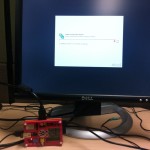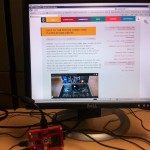A couple weeks back my main desktop gave up the ghost after 6 years of usage. This leaves me without a desktop at home and if something were to arise that had to keep me home I would now have no way to work from home.
So I was thinking…
What about the VMware Open View client, that was a source code project on Google Code that allowed extra platforms to build the RDP based View client on whatever platform. Well it turns out that was closed suddenly over a year ago but in my searching for it it turned out someone had managed to get the binary packages working on the Pi with a Debian ARM package that seemed to exist.
The Raspberry Pi thin client project seemed to have what I was looking for out of the box. A View client that works with current View deployments and half a dozen other thin client packages for other platforms.
Problems problems problems
View client:
My Pi was on Ethernet to start, I opened up view put in my connection server and hit connect. It pops up with the MOTD and I continue, enter my credentials and then the desktops available to me appear. Great so far! I click the desktop pool the wheel spins and POOF the window goes away.
-I made sure RDP was selected
-I set the window to small in case the poor Pi couldn’t handle it
Poof! window goes away!
CPU speed:
CPU is set to the default 700mhz, this isn’t really a problem from a technical standard, the Pi is default a 700mhz ARM however all the applications crawl at this speed, including the View client
Wifi:
Wifi did not work out of the box, it did not detect my USB wifi and this Wifi has worked perfectly with all other Pi projects I’ve done in the past.
Boot Splash video:
It ran longer than the actual boot process, on a 4:3 screen you can see the booted desktop in the background and you’re still stuck watching the movie
Fixes Fixes Fixes
So I downloaded this for the sole purpose of using it for View so when that didn’t work I was a little disheartened but this was still the best bet I had so I wasn’t about to give up on it.
View fixes:
So as I said earlier, it worked up until showing me my available desktop pools and then it closes when you select one. I tried a multiple set of options, smallest window size, RDP, Full screen, windowed etc and nothing yet. I checked google and wasn’t getting far there other than a couple people on the RpiTC forums with the same problem.
It wasn’t looking good.
So for the hell of it I decided to run the app in LXterm to see if it said anything useful to STDout and it did. First it told me where it saved its logs. /tmp/vmware-view-some#-tmp.log and secondly when it closed it gave me a useful error.
“vmware-view-usb cannot be started: file does not exist” once again I hit google and got nothing but KB’s and other stuff and once again it didn’t look good.
Then for some reason I decided to just touch vmware-view-usb in /usr/bin and guess what the hell happened? It worked.
View problem solved! works great, even faster than some of proper full desktop versions.
CPU Speed:
700MHZ just wasn’t cutting it, everything dragged and pushed CPU to max. The nice folks had an overclock config set already in /boot/config.txt but commented out. Easy solution, Solved.
I also cleaned out the autostart applications for LXDE, commented out all startup applications and added @vmware-view –fullscreen
The reason for this is so the system boots up straight to the View client like a proper View thin client. Removing the desktop stats application (showed cpu/ram on the desktop) and the other startup apps greatly reduced CPU overhead
Wifi:
So the system worked great on ethernet but at home I use mainly wifi so the fact that it wasn’t detecting my wifi at all was a serious problem and even a deal breaker. The system appeared to actually see the wifi card when I did ifconfig wlan0 but it wasn’t connecting to anything and wpa_gui always reported it could not get status from wpa_supplicant.
What seems to be the issue is no wpa_supplicant.conf file existed and there was no proper definition of wlan0 in /etc/network/interfaces. I followed a simple guide here and the wifi issue was resolved. I can see why wifi may have been overlooked a wireless connection does impact thin client performance but the View client performance is still more than acceptable. Problem solved.
Boot splash video:
It is a neat looking video, it looked great at home on the 40inch HD TV but on my 4:3 monitor you can quite easily tell the system booted longer before the video was over so it was also kind of annoying. The videos are located in /opt all you need to do to quickly fix this is rename them. If you want your own fancy boot videos they are in m4v format just replace the files with something of your own.
Solved.
Project summary
So it took some tweaking and some unusual fixes to get this to do exactly what I needed but after all is said and done I am quite pleased with the results. Now I have an SD card I can pop into any of my Pi’s and immediately bring up a View Client for work. Small investment big gain for me.


Hi – I’ve been trying to get VMware view client to work on Raspberry Pi – I found the same issue as you did, that vmware-view-usb doesn’t exist. I’ve been able to get past that but I’m not having any luck connecting. – I’m just wondering what base-image did you you and/or did you make any further mods? I’m using the RPiTC project. Or even if you could provide me with a copy of your image, so I can compare, that would be great! Thanks!
I used the Thin client project as well as my base and then did the things I mentioned in the blog post. I might be able to provide the image if i can find the SD card it was on. I haven’t had to use it for View in several months…. I’ll take a look after Xmas week and if I do post it ill only be leaving it up for a few days so keep an eye out.
Same issue here, the USB file does not exist at all, thank you for the info and anything else u can post…. maybe even just post the USB file itself? thank you again.
I covered how to fix that above “just touch vmware-view-usb in /usr/bin and guess what the hell happened? It worked.”
So essentially just make a blank file named vmware-view-usb and put it in /usr/bin